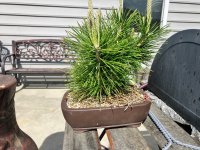In order to answer meaningfully we need to differentiate for the outcomes you want to achieve.
In most places we can prune Pinus any time of year. Normal pruning won't kill a pine but time of year can achieve different results.
Second, we need to differentiate between hard pruning and decandling. Again, different results with both as well as different results at different seasons.
Also need to be aware that different pines react differently. Dual flush species can grow several times each year. Single flush species usually only elongate the buds in Spring.
While singe flush species can also be pruned any time of year, the following pruning/growth tables apply to dual flush pines and is my experiences with pines. You are welcome to take it or leave it as you see fit.
Hard pruning is cutting back below current season growth. Pines have developed the ability to grow new buds from the base of any healthy needle. Some pines can also develop new buds from bare wood (back buds). Some species are better at this than others so get to know the species before cutting back to bare wood. Hard pruning is very useful when making initial reductions in developing stock and to force new buds below the current growing tips. I use hard pruning to reduce developing pines and to get useful shoots on overgrown, long branches.
- Hard prune in Spring = new buds form quickly and grow strongly. Usually longer bare 'necks'
- Hard prune early summer = new buds form and open but don't grow as strong. Usually shorter bare 'necks'
- Hard prune late summer/ Fall = new buds will form but may not open before dormancy. Subsequent growth the following Spring is usually strong with longer bare 'necks'
- Hard prune Winter = buds may not form immediately but should emerge as the trees come out of dormancy in Spring. Growth is usually strong with longer bare 'necks'
Decandling is removing the current season's shoots close to the junction of last year and base of new shoot. It can be done early, before the needles emerge or later after the needles have opened, in which case the term 'decandling' is not particularly accurate but still generally applied. Different results with both options. Decandling usually results in a cluster of new buds around the junction between last year and this year's shoot that has been cut. You may also get some buds further back on the branches.
- Decandling early Spring = new buds that open and grow strong, often with longer bare 'necks'
- Decandle early summer = smaller new shoots, usually with little or no bare 'neck'. This gives us the best result if compact growth is the desired result and is the usual timing recommended. Optimum timing will depend on local climate with some areas decandling a few weeks earlier or later than others to get best results.
- Decandle late summer/ fall = similar to hard pruning above - buds form but may not open before dormancy. Those buds will then be strong in the Spring flush.
- Decandle winter = almost hard pruning now at this time of year. Similar results to hard pruning winter but most buds restricted to the junction of new and old growth.
The above guide only talks about subsequent growth. Results will also vary depending on the vigour and health of your tree and of individual parts of a tree. Stronger trees will usually yield more, stronger new buds. Weaker trees and weaker shoots can sometimes fail to form new buds. Best to get trees healthy and growing well before applying any pruning.
As with all pruning of all species, any reduction of growth will slow development and thickening of the tree so, at some stages of growth, we need to balance growth with pruning to maintain viable growth where we need it.
Different forms of pruning are not necessarily mutually exclusive. We may be candle pruning some parts of a tree in development, to maintain shorter growth and ramification, while allowing another part to grow and then hard prune.
We may allow some weaker parts of an established pine to grow freely to build vigour then hard prune while decandling the rest of the same tree to maintain ramification in those areas.








